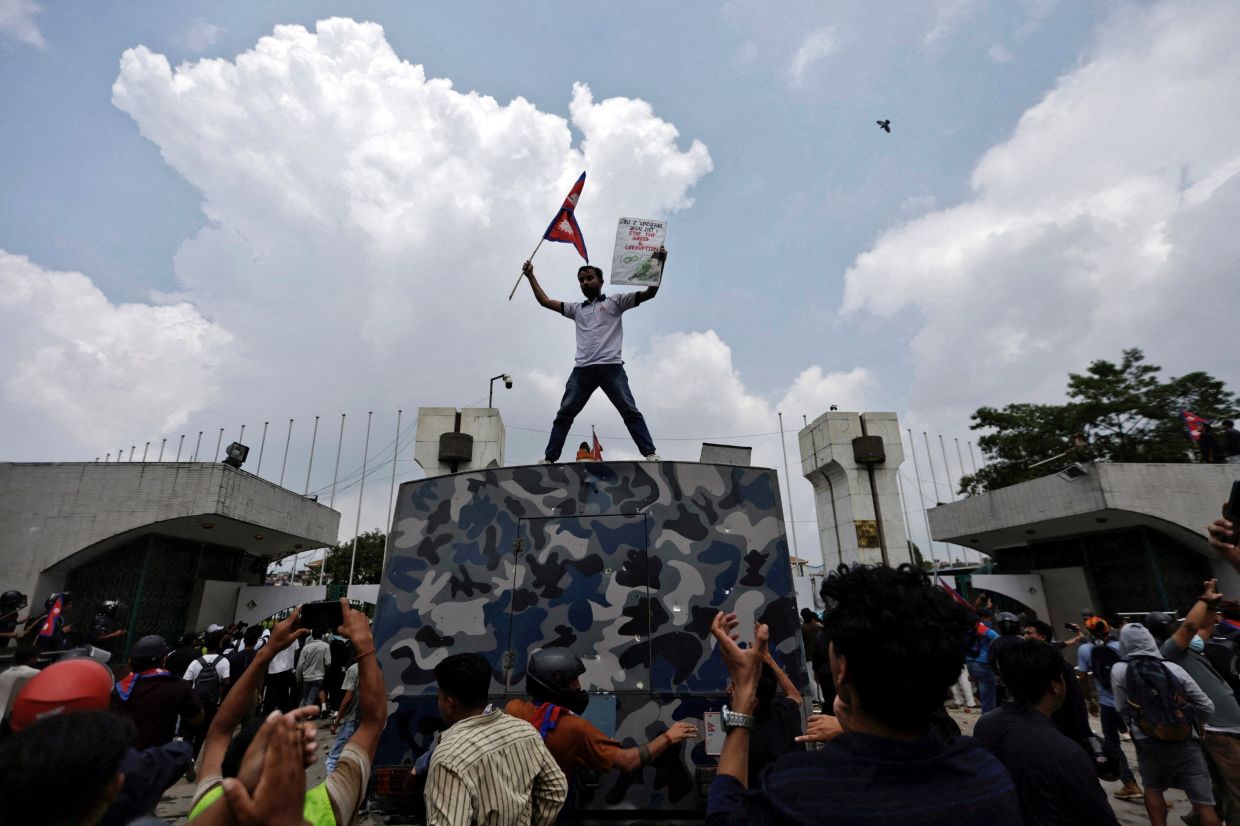When Nepal’s government abruptly banned more than two dozen social media sites earlier this month, Rakshya Bam and thousands of her “Gen Z” compatriots sprang into action.
Using VPNs to circumvent official bans on Instagram, Reddit and Discord, hordes of young demonstrators – some still in school uniforms – took to the streets with a range of grievances, including unemployment and corruption. Special contempt was reserved for “Nepo Kids”, the children of elites who flaunted their wealth online while more than 20% of Nepalis live in poverty.
“We weren’t planning for it. It was such a spontaneous movement,” Bam, a 26-year-old activist who emerged as one of the leaders of the demonstration, said last week. Nearby, burned-out cars and graffiti-covered walls attested to the upheaval. “They were not able to ban corruption, so they banned the digital space instead. It was really a trigger point for all of us.”
The protests escalated dramatically on Sept 8, when police fired on groups of young demonstrators, killing more than 20 people. A day later, protesters set fire to government buildings and stormed parliament, breaking through police barriers. The homes of top officials, including the prime minister’s residence, were burned down, along with the five-star Kathmandu Hilton, which opened last year. By day’s end, the prime minister had resigned.
The chaos left more than 70 dead, making it Asia’s deadliest protest this year. It was a more violent version of street rebellions that recently rocked countries like Indonesia and the Philippines, and moved faster than the regime-toppling movements that swept Bangladesh last year and Sri Lanka the year before. The wreckage in Nepal stands as a stark warning to leaders across the world who are ruling over increasingly restless populations of young people seething over corruption, joblessness and a privileged and out-of-touch elite.
After the bloodshed, the army invited Bam and other protest leaders for talks on who should lead an interim government. The young activist rejected old establishment candidates and instead held a straw poll on Discord. The overwhelming choice was Sushila Karki, a tough 73-year-old former Supreme Court justice with a reputation for being outspoken. She was soon sworn in as the country’s first female leader.
“We can say that young people have power,” Bam said from a Kathmandu coffee shop that weeks before had served as an impromptu gathering point for demonstrators. “They have less experience but they have the energy.”
Whether that will last is anyone’s guess. Sandwiched between Asia’s superpowers China and India, and beloved by mountaineers for its snowy Himalayan peaks, Nepal is no stranger to violent uprisings. Within the last three decades, it has withstood a Maoist insurgency, a royal-family massacre and off-and-on street protests. Former insurgents, monarchists and old-money tycoons rub shoulders while competing for power.
It is also among the region’s poorest nations, with jobs for young people so scarce that nearly one in five under the age of 24 lives overseas. Over a quarter of Nepal’s gross domestic product comes from remittances – one of the highest rates in the region, ahead of countries like the Philippines and Bangladesh.
It’s also a country where much of life is conducted on social media – used not just for sharing personal updates but for keeping in touch with friends and family overseas and, for small businesses, to advertise and sell their wares. Like many countries, Nepal had been trying for years to institute guardrails on social media platforms operating in the country. On Sept 4, the government banned more than two dozen platforms for failing to meet a deadline for new requirements.
The blowback was immediate, with millions of youths rallying to protest. The unrest quickly mushroomed, absorbing longstanding youth grievances – from frustrations over corruption and excessive red tape to fury against “Nepo Kids”.
Many young Nepalis were able to circumvent the government’s online blockade with the help of VPNs. Calls to the streets often took the form of straightforward social media posts: for example, a TikTok video of a burning candle with text describing the gathering point for an upcoming protest, or a 24-second video asking if Gen Z were ready, proclaiming that “we’re not vibin” with the corruption.
“There was this trend which started in the Philippines, then Indonesia, and eventually spread to Nepal, which was this trend of exposing Nepo Kids,” said Suraj Raj Pandey, an entrepreneur involved in the tourism business.
The protests grew into a mob that ransacked the private homes of government ministers, and dramatic videos circulated online of leaders’ families dangling from helicopters to escape the violence. After the resignation of Prime Minister K.P. Sharma Oli, the government lifted its social media ban and the army enforced a nationwide curfew. Three days after Oli’s ouster, an interim government was in place.
But the protest movement now faces new challenges, including whether the triumphant protesters can translate their success into lasting political change that addresses Nepal’s deeper woes.
At a vigil last week, dozens of youngsters stood, demanding accountability for the killings of protesters. Among them was Sarisma Thapa, a 23-year-old from Udayapur, in eastern Nepal. Thapa said she left Nepal at 18, and was working as a bartender in the Maldives when the protests began. She rushed home when she heard about the deaths.
“My country already failed me,” she said. Thapa said she wished she could stay and work in Nepal but that her dream of starting a waffle shop in Kathmandu felt out of reach owing to the bureaucratic hurdles of opening a business. “I only came here because these people are dead.”
Many young people expressed similar frustration over corruption, red tape and a system that they said stifles everyone but the rich or well-connected. Opening a business requires endless paperwork and, in many cases, outright bribery. Nepal routinely scores poorly on global corruption rankings: Transparency International ranked the country 107 out of 180 in its most recent Corruption Perceptions Index.
“If you want to register a company, if you don’t bribe, it won’t get registered for three months,” said Pandey. “If you want to get your name approved, you have to start bribing right then and there.”
Ayusma Aryal, a 27-year-old accountant, said the culture of bribery was endemic in the country. “In Nepal, everyone bribes. You need to bribe to pay taxes,” she said. “We fought for political change. We have to keep fighting for economic change.”
For the interim government, the new challenges are multifold, including rebuilding swaths of the city torched by protesters, and stemming the flight of foreign investment after the destruction of luxury hotels like the Hilton and Hyatt Regency.
The riots struck just ahead of a major religious festival and the country’s busy fall tourism season, and many travellers have canceled plans. Ratings agency Fitch on Friday said the upheaval had dampened growth prospects and hurt business confidence.
“We need a business revival plan,” said Anjan Shrestha, senior vice president of the Federation of Nepalese Chambers of Commerce and Industry, a business group.
Repair costs could exceed those of the devastating 2015 earthquake, which flattened sections of Kathmandu and resulted in billions of dollars in damages, according to one minister in the new government, who requested anonymity because discussions are still private.
Yet Nepal has a few factors working in its favour as it looks to rebuild, said Sujeev Shakya, an economist and chair of the think tank Nepal Economic Forum, noting its roughly US$20bil (RM84.28bil) in foreign currency reserves and relatively large tax base. “We are not cash-strapped,” he said. “It’s not like Sri Lanka. It’s not like Bangladesh.”
Karki has said her main priority was ensuring free and fair elections, scheduled for March 5, are held on time.
“We are here for only six months to complete the task given to us and transfer the responsibility to the upcoming government and ministers,” she said in a public address. She has also pledged to address the demands of the Gen Z protesters and their concerns about corruption.
For the Gen Z protesters, the looming question centres on whether their movement galvanises into a political force capable of sustaining its challenge to the country’s establishment. So far, Karki has appointed several ministers to her government, and all are widely seen as technocrats rather than political insiders, a fact that has earned widespread approval from many in the Gen Z movement.
The minister who spoke to Bloomberg said the new cabinet has been working closely with a small group of leaders in the Gen Z movement to ensure that their concerns are being heard. The longer-term goal is that the young protest leaders eventually attain the skills to hold leadership posts, he said.
Bam, the protest leader, said she hoped the movement would evolve into a coherent political entity that could eventually stand in elections.
“This is just the first phase,” she said. “There are many phases.”
Pandey, the entrepreneur, was also optimistic.
“There has been a lot of damage for sure,” said Pandey. “But even after all the losses, we are very hopeful of all the changes that have happened.” – Bloomberg






